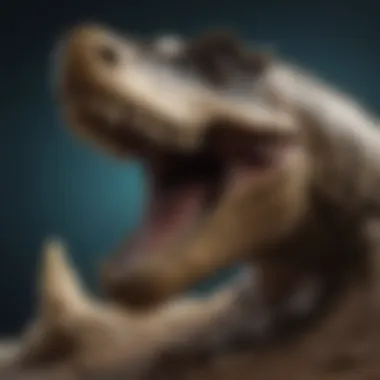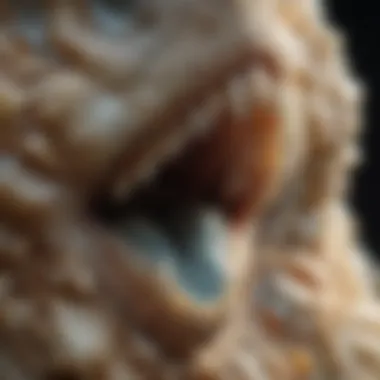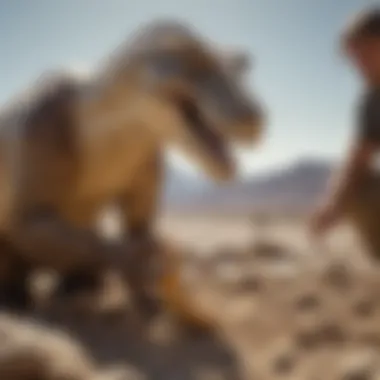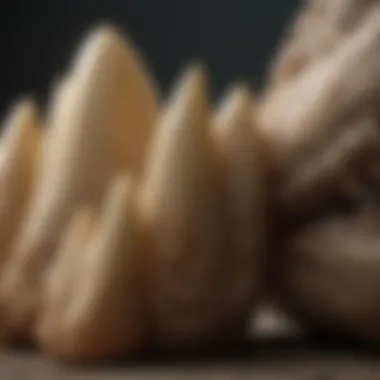Unlocking the Mysteries of Mosasaur Tooth: An In-Depth Exploration


Rock and Fossil Identification
Mosasaur teeth are intriguing relics that offer valuable insights into the world of prehistoric marine reptiles. These teeth, often found in sedimentary rocks, serve as essential markers of ancient ecosystems. When identifying mosasaur teeth, collectors look for distinct characteristics such as conical shapes, serrated edges, and enamel composition. Special tools like handheld magnifiers and UV lights aid in the examination process, allowing collectors to distinguish genuine specimens from replicas.
Historical Context
To truly understand the significance of mosasaur teeth, we must delve into their historical context. These teeth date back to the Late Cretaceous period, showcasing the dominance of mosasaurs in ancient seas. By examining the geological formations where these teeth are discovered, researchers uncover a narrative of evolution and ecological change. Noteworthy discoveries of mosasaur teeth have provided crucial evidence for paleontologists, shedding light on the behavior and diversity of these formidable marine reptiles.
Fossilization Process
The fossilization process of mosasaur teeth is a complex yet fascinating journey. It begins with the deposition of calcium-rich sediments, which gradually encase the teeth over millions of years. Through a series of mineralization and petrification stages, the organic matter in the teeth is replaced with minerals, preserving their structure. Understanding this process is key to properly excavating and handling mosasaur teeth to ensure their integrity and scientific value.
Significance in Paleontology
Mosasaur teeth hold immense significance in the field of paleontology, offering a glimpse into the ancient world of marine predators. By studying the morphology and wear patterns of these teeth, scientists can reconstruct the feeding habits and ecological roles of mosasaurs. These findings contribute not only to our understanding of prehistoric ecosystems but also to ongoing research on marine biodiversity and evolutionary trends. As valuable artifacts of a bygone era, mosasaur teeth continue to spark curiosity and drive exploration into Earth's distant past.
Introduction
In the vast realm of paleontology lies a captivating subject that continues to intrigue scientists and enthusiasts alike - the world of mosasaur tooth. This article embarks on a journey to unravel the significance, characteristics, and historical context of these fascinating relics of prehistoric marine reptiles. Through exploring the formation, discovery, and implications of mosasaur teeth, we aim to shed light on their pivotal role in understanding the ancient marine ecosystems and enriching the fossil record with valuable insights. Let us delve deep into the enigmatic world of mosasaur teeth and uncover the secrets they hold.
Understanding the Significance
The Role of Mosasaur Teeth in Paleontology
Delving into the role mosasaur teeth play in paleontology unveils a crucial aspect of fossil analysis. These teeth serve as key indicators for identifying different species of mosasaurs and understanding their dietary habits and evolutionary adaptations. The intricate structure and unique features of mosasaur teeth provide paleontologists with valuable data to reconstruct the lives of these ancient marine predators accurately. Through detailed analysis of these fossilized dental remains, scientists can piece together the puzzle of prehistoric marine creatures' behaviors and interactions, contributing significantly to expanding our knowledge of evolutionary history.
Impact on Understanding Prehistoric Marine Ecosystems
The impact of mosasaur teeth on comprehending prehistoric marine ecosystems is profound. By studying the distribution, morphology, and wear patterns of these teeth, researchers can glean insights into the dynamics of ancient food webs and ecological relationships within marine environments. The fossilized record of mosasaur teeth not only provides information about individual species but also offers a window into the larger ecosystem they inhabited millions of years ago. Understanding the role of mosasaur teeth in paleoecology enhances our ability to reconstruct prehistoric marine environments with greater accuracy and infer the ecological roles these formidable reptiles played in ancient seas.


Brief Overview of Mosasaurs
Evolutionary History
Exploring the evolutionary history of mosasaurs unveils a fascinating narrative of adaptation and diversification in Mesozoic marine environments. These ancient marine reptiles evolved from land-dwelling ancestors to dominate the oceans during the Late Cretaceous period, showcasing remarkable morphological changes and behavioral shifts. The study of their evolutionary trajectory through fossil evidence provides essential clues to how mosasaurs thrived in diverse marine habitats and adapted to changing environmental conditions over millions of years.
Unique Adaptations for Marine Life
Mosasaurs exhibited a plethora of unique adaptations tailored to their marine lifestyle, ranging from streamlined bodies to specialized limb modifications for efficient swimming. Their extensive fossil record showcases evidence of sophisticated sensory organs, powerful jaws, and teeth adapted for capturing and consuming prey in aquatic environments. Understanding these distinctive adaptations offers invaluable insights into the evolutionary success of mosasaurs as top predators in ancient seas and the ecological niches they occupied amidst fierce competition for resources.
Formation of Mosasaur Teeth
Mineralization Process
The mineralization process of mosasaur teeth is a complex and intricate journey that begins with the deposition of minerals within the dental tissues. Through a combination of biological and geological processes, organic matter within the teeth undergoes mineral replacement, transforming them into resilient structures capable of enduring millions of years of fossilization. The mineralization of mosasaur teeth not only preserves intricate details of dental morphology but also provides a glimpse into the chemical composition of ancient marine environments and the post-mortem diagenetic processes that shape fossil preservation.
Structural Composition
The structural composition of mosasaur teeth reveals a fascinating blend of organic and inorganic materials shaped by selective pressures and functional requirements. These teeth exhibit varying degrees of hardness, enamel thickness, and crown morphology, reflecting the diverse feeding behaviors and dietary preferences of different mosasaur species. By examining the microscopic structure and elemental composition of mosasaur teeth, researchers can unravel clues about the environmental conditions in which these reptiles lived and the evolutionary pathways that led to the development of their unique dental adaptations.
Characteristics of Mosasaur Teeth
Mosasaur teeth hold a pivotal role in this article's exploration into the fascinating world of these prehistoric marine reptiles. The characteristics of Mosasaur teeth provide essential insights into their evolution, dietary habits, and ecological niches. By examining the size and shape variability, dental structure, and surface texture, researchers can unravel the adaptations developed by Mosasaurs for their marine lifestyle. These teeth are not just fossils but windows into the past, offering a tangible connection to ancient marine ecosystems.
Size and Shape Variability
Differences Across Species
Diving deeper into the realm of Mosasaur teeth, the variations in size and shape across different species showcase the intricate adaptations these reptiles underwent. Each species' dental morphology is uniquely tailored to its specific feeding behaviors, highlighting the level of specialization present in prehistoric marine reptiles. Understanding these differences provides paleontologists with crucial information for species identification and ecological niches, enriching our knowledge of Mosasaur diversity and evolution.


Adaptations for Feeding Behavior
Exploring the adaptations for feeding behavior unveils the functional aspects of Mosasaur teeth. From razor-sharp teeth designed for slicing through prey to blunt teeth suited for crushing shells, each adaptation reflects the dietary preferences and hunting strategies of these ancient predators. By delving into how these adaptations influenced feeding efficiency and prey selection, researchers gain a deeper understanding of the complex interactions within prehistoric marine food webs.
Dental Structure and Function
Teeth Regeneration
A remarkable feature of Mosasaur teeth is their ability to regenerate throughout their lives, ensuring continuous replacement as older teeth wear down or break. This adaptive mechanism enabled Mosasaurs to maintain optimal dental functionality despite the challenges posed by their hunting and feeding behaviors. Through detailed studies of tooth regeneration patterns, scientists can decipher the growth rates, replacement cycles, and potential injuries faced by these marine reptiles, offering insights into their lifespan and physiological resilience.
Bite Mechanics
The bite mechanics of Mosasaurs played a crucial role in their predatory strategies and feeding efficiency. By analyzing the structural design of their teeth and jaw muscles, researchers can reconstruct the biting mechanisms employed by these reptiles to capture and consume prey. Understanding how bite force variability and tooth morphology influenced feeding success provides valuable clues about the ecological roles of different Mosasaur species and their positions in ancient marine food chains.
Surface Texture and Wear Patterns
Insights into Dietary Habits
The surface texture and wear patterns present on Mosasaur teeth serve as indicators of their dietary habits and food processing methods. By examining the microscopic details of enamel wear and dentin exposure, paleontologists can infer the types of prey consumed by these reptiles and the repetitive motions involved in their feeding behaviors. This microscopic evidence provides valuable information about the trophic interactions within prehistoric marine ecosystems and the coevolutionary relationships between Mosasaurs and their prey.
Erosion Effects Over Time
Investigating the erosion effects observed on Mosasaur teeth over geological time scales offers insights into diagenetic processes and fossil preservation. By studying how factors such as sediment abrasion, mineral dissolution, and post-mortem taphonomic changes impact tooth surfaces, researchers can refine their methods of fossil analysis and interpretation. These erosion patterns not only reveal details about the burial histories of Mosasaur fossils but also inform strategies for their long-term conservation and scientific study.
Discovery and Excavation
In the vast expanse of paleontological exploration, the realm of Discovery and Excavation holds a pivotal role. The process of uncovering and unearthing ancient relics is crucial in piecing together the puzzle of prehistoric life forms. In the context of mosasaur teeth, each excavation provides a window into the past, offering invaluable insights into the anatomy and behavior of these fascinating marine reptiles. Through meticulous excavation, researchers can unearth specimens that shed light on evolutionary adaptations and ecological interactions long lost to time. These excavations not only broaden our understanding of ancient marine ecosystems but also contribute significantly to the scientific knowledge base surrounding mosasaurs.
Fieldwork Procedures


- Identifying Fossil Sites: Identifying suitable fossil sites is a cornerstone of successful paleontological fieldwork. The precise selection of excavation sites is influenced by a myriad of factors, including geological formations, sedimentary layers, and past fossil discoveries. By locating fossil-rich areas with promising geological characteristics, researchers maximize the chances of uncovering well-preserved specimens. This targeted approach to site identification plays a critical role in the efficiency and success of fieldwork expeditions focused on mosasaur teeth.
- Tools and Techniques: Equipped with a diverse array of tools and techniques, paleontologists embark on fieldwork prepared to meticulously extract, document, and preserve fossil specimens. From brushes and chisels to delicate dental picks, each tool serves a specific purpose in the delicate process of excavation. Advanced imaging technologies such as 3D scanning and photography allow for detailed documentation of fossil remains in situ. These tools and techniques ensure that valuable information is captured without compromising the integrity of the specimens, paving the way for detailed analysis and interpretation in research settings.
Paleontological Significance
In the realm of mosasaur research, the significance of paleontological endeavors resonates deeply. Each discovery contributes not only to our understanding of these ancient marine reptiles but also provides invaluable data for comparative analysis and scientific inquiry. The contributions stemming from the paleontological study of mosasaur teeth extend far beyond the realm of mere fossil identification. They provide crucial data for the reconstruction of ancient marine environments, shedding light on ecological dynamics and evolutionary pathways.
- Contributions to Scientific Research: The meticulous study of mosasaur teeth yields a wealth of data that contributes significantly to scientific research. By examining the structural characteristics, wear patterns, and mineral composition of these teeth, researchers can infer valuable insights into mosasaur dietary preferences, feeding behavior, and ecological roles. These research findings not only enhance our understanding of marine reptile biology but also inform broader discussions on evolutionary adaptations and paleoecological dynamics.
- Insights into Ancient Marine Environments: The study of mosasaur teeth provides a unique window into the past, offering insights into the environmental conditions and ecological relationships that prevailed during the Age of Reptiles. Through careful analysis of tooth morphology, researchers can reconstruct aspects of ancient marine ecosystems, including predator-prey interactions, species diversity, and habitat preferences. These insights into ancient marine environments deepen our appreciation for the intricacies of prehistoric life and the dynamic interplay between organisms and their habitats.
Conservation and Preservation
Amid the excitement of discovery and exploration, the importance of conservation and preservation efforts cannot be overstated. Ethical considerations and strategic methods for long-term storage are essential components of responsible paleontological practice. By maintaining high ethical standards and implementing effective preservation techniques, researchers ensure that valuable fossil specimens remain accessible for future generations of scientists and enthusiasts.
- Ethical Considerations: Ethical considerations shape every aspect of paleontological work, from fieldwork practices to museum curation. Respecting fossil sites, local communities, and indigenous knowledge systems is paramount in fostering collaborations and advancing research endeavors sustainably. By upholding ethical standards, researchers not only protect the integrity of their work but also contribute to a culture of respect and reciprocity within the scientific community.
- Methods for Long-Term Storage: Ensuring the long-term preservation of fossil specimens requires specialized methods tailored to the unique characteristics of each specimen. From temperature and humidity control to customized storage solutions, preserving the integrity of mosasaur teeth demands meticulous attention to detail. Institutions dedicated to fossil curation play a vital role in safeguarding these valuable scientific resources, maintaining collections that serve as invaluable repositories of paleontological knowledge and historical insights for generations to come.
Historical Context and Cultural Impact
Delving into the historical context and cultural impact of mosasaur teeth adds a layer of depth to the study and appreciation of these prehistoric marine reptiles. Understanding how these creatures were perceived and represented in art and literature provides valuable insights into the mindset of past societies and the role of paleontology in shaping our understanding of history. Exploring the cultural significance of mosasaur teeth uncovers a rich tapestry of human imagination and scientific curiosity, linking ancient myths and modern scientific discoveries.
Depictions in Art and Literature
Mythological Interpretations
Exploring the mythological interpretations surrounding mosasaur teeth reveals a fascinating blend of imagination and scientific speculation. Throughout history, these formidable reptiles have sparked myths and legends, with their fossilized remains often interpreted as dragon bones or sea monsters by ancient cultures. The mythical allure of mosasaurs continues to captivate artists and writers, inspiring fantastical tales and imagery that blur the lines between reality and fantasy. Mythological interpretations provide a creative lens through which to appreciate the awe-inspiring nature of mosasaur teeth, highlighting their enduring presence in human culture.
Influence on Popular Culture
The influence of mosasaur teeth on popular culture extends beyond mere fascination with prehistoric creatures; it reflects our enduring curiosity about the mysteries of the past. From blockbuster movies to children's books, these ancient marine reptiles have left an indelible mark on popular culture, serving as both educational tools and sources of entertainment. The recognition of mosasaur teeth in mainstream media underscores their iconic status in the realm of paleontology, shaping public perceptions and generating interest in the natural world. Their cultural impact resonates through art, literature, and media, bridging the gap between scientific research and popular imagination.
Scientific Contributions to Paleontology
Advancements in Taxonomy
Advancements in the taxonomy of mosasaur teeth have revolutionized our understanding of prehistoric marine ecosystems. Through meticulous study and categorization, paleontologists have elucidated the phylogenetic relationships among different mosasaur species, shedding light on their evolutionary history and behavioral adaptations. Taxonomic developments provide a systematic framework for classifying and comparing fossil specimens, enabling researchers to trace the intricate evolutionary pathways of these ancient reptiles. The taxonomic refinement of mosasaur teeth contributes invaluable data to paleontological research, enhancing our knowledge of past biodiversity and ecological dynamics.
Reconstructing Prehistoric Environments
The process of reconstructing prehistoric environments using mosasaur teeth offers a glimpse into the ecological landscapes of the past. By analyzing the distribution and morphology of fossilized teeth, scientists can infer aspects of ancient marine habitats, such as water temperature, prey availability, and predator-prey interactions. This reconstructions provide a holistic perspective on the paleoenvironments inhabited by mosasaurs, painting a vivid picture of their evolutionary niche and ecological roles. Studying mosasaur teeth within their paleoenvironmental context not only enriches our understanding of ancient ecosystems but also guides conservation efforts and informs predictions about future environmental changes.







